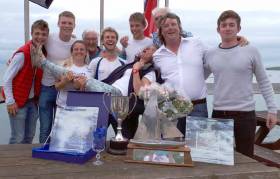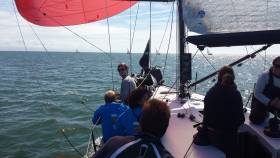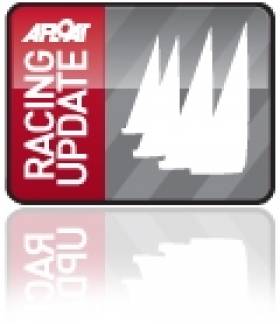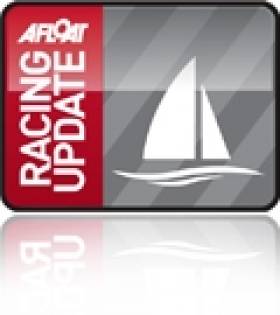Displaying items by tag: Abersoch
Fools Gold Wins at Abersoch Keelboat Race Week
Waterford Harbour Sailing Club's A35, Fools Gold, skippered by Rob McConnell returned to Wales at the weekend for another regatta campaign. Having won the IRC Welsh Nationals in August in Pwllheli, the Dunmore East boat has gone on to win Abersoch Keelboat Week, IRC division one by half a point.
Fools Gold was up against a range of cruiser–racers in her ten boat fleet including J109s, J97s, Corbys and a Beneteau 234.7. Results are here.
16–year–old helmsman, Dunmore East 420 dinghy champion, Geoff Power got his first taste of cruiser–racing on the tiller of Fools Gold.
A two race retirement after a broken rig, was no barrier for McConnell's crew who, among others, squeezed out ISORA overall leader Mojito for the win.
The Wateford crew also won 'Best Visiting Boat' Trophy at Abersoch. The win completes a successful season for McConnell who also clinched Sovereigns Cup overall honours in July.
Royal Cork's Jump Juice Leads At Abersoch Keelboat Week
Conor Phelan's much travelled Ker 37 Jump Juice from Royal Cork Yacht Club leads class one of Abersoch keelboat week in North Wales this week. Five races of the series have been sailed so far with one discard. The Crosshaven entry, with Maurice O'Connell onboard as part of the Munster crew, leads the Jon Batson skippered Dehler 36 Wombat by a point and a half. There are three more races left to sail today and two tomorrow. Full results in the nine boat class one fleet are here
Abersoch Dinghy Week 2014 Celebrates Largest Fleet Since 2007
#abersochdinghyweek – The dinghy is dead? Think again. Across the Irish Sea in North Wales, Abersoch dinghy week has had its biggest entry since 2007.
It promised to be bigger and better and, with 273 entries across 51 fleets the Crewsaver Abersoch Dinghy Week 2014 was certainly an event not to be missed.
The extremely warm weather enabled the competitors to top up their sun tans! This did however result in light winds all week. This did not dampen the sailors' spirits with hot sun, sea & sand there was still plenty of fun to be had.
This year saw the successful introduction of a smaller course with committee boat starts for the Topper, Tera and Optimist fleets, resulting in the spectacular sight of 50 youth boats enjoying the competitive side to sailing.
Crewsaver Abersoch Dinghy Week Organiser Andy Teague says 'I am amazed at the number of entries with competitors coming from as near as Pwllheli and as far as Dubai. I would like to thank everyone for making it such a great event.'
Hannah Burywood, Marketing Coordinator for Crewsaver comments 'Crewsaver Abersoch Dinghy Week is an extremely well organised, enjoyable event that every dinghy sailor should have noted in their calendar.'
With this in mind jot the 2015 date in your calendar: Registration, 25th July 2015 Sailing, 26th - 31st July 2015. Could Ireland revive its own dinghy week concept?
Complete results here
Three Irish in Dragon Top Five
Three Irish Dragons made the top five at the Northern Area Championships last weekend, just across the water in Abersoch. South Caernarvonshire Yacht Club hosted a small fleet, sailing in gusty conditiond of up to 25 knots. Royal St George YC vice-commodore Martin Byrne topped the Irish entries with five seconds in seven races, but couldn't edge out ahead of Tim Tavinor and his crew who pocketed a brace of bullets to walk away deserved leaders.
Just thirteen boats lined out for the event, with Kin (Simon Brien) and Phantom (David Williams) the other two Irish boats alongside Jaguar.
Results HERE
































































